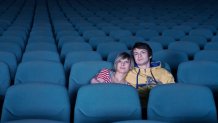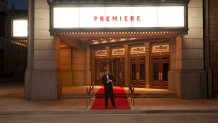Date night at the movies is woven into the very fabric of Americana. It's a tradition that dates back to ... well, the advent of movie theaters. But like many traditions in 2020, the movie-going experience came to a grinding halt as theaters across the country shuttered because of the COVID-19 pandemic.
Will that movie experience ever be the same? Or will movie lovers en masse pivot to streaming services and Video on Demand, content to watch releases from the comfort and safety of their own couches?
The short answers are yes. And no. Yes, the movie-going experience will be different, in ways both big and small. But no, the movie theater is not going the way of BetaMax or the 8-track. (If you don't get those references, ask your parents.)
For starters mask are a given. But beyond that say goodbye to strolling over to the concession area to put a little extra butter on your popcorn. The same goes for adding condiments to your hot dogs. And bringing back that soda cup for a refill? Forget it.

John Fithian, president and CEO of the National Association of Theater Owners, a non-profit that advocates for the rights of thousands of theaters owners across the country, says cinemas have been working tirelessly to prepare for the return of customers as pandemic restrictions slowly lift across the nation.
Like everywhere else it's been a challenging six months for the industry. Fithian estimates there's been a $5 to $6 billion dollar loss domestically and as much as $20 billion globally since the pandemic forced theater owners to shut their doors. But to borrow the old movie adage "If you build it, they will come," Fithian believes once restrictions lift, customers will return.
"We know movie-goers will come back to the theaters if we have two things: If we have new movies for them... but also if we have a safe environment. They have to have both," he says. Fithian says industry experts have sat down with leading epidemiologists over the last several months to design comprehensive safety protocols in the cinemas that are now implemented in the 45 states where theaters have reopened.
So what does this mean? And how will your movie experience be different from before? Fithian says the changes will be both subtle and obvious to all.

For starters, families and small groups can sit together, but specific algorithms will ensure there are empty seats around your group to meet social distancing guidelines. And of course masks, masks, everywhere. There will be masks galore, for both patrons and employees. And if you don't have one, Fithian says, they'll politely ask you to go back and get one. Or, depending on the location of the theater, provide one for you. You can take masks down while facing the screen snacking on popcorn...but otherwise you'll be expected to keep covered.
"There are all kinds of cleaning protocols," Fithian says. "Food and beverage service is different now than it was before. You won't have contact with your condiments or put butter on your own popcorn. You won't come back for refills in the same cup. And we are minimizing contact between employees and patrons."
Between the masks, the social distancing and better air ventilation in theaters "we believe we've designed a really safe auditorium for our patrons," Fithian says.
That's good news to the ears of Dan Mintz. Mintz, a filmmaker and creative head of DMG Entertainment and Valiant Comics, helped spearhead the recent Vin Diesel thriller "Bloodshot," which has the unfortunate distinction of being one of the last major blockbusters to ship to theaters just before the pandemic hit.
"We were the last premiere and literally the next day... there was already kind of forewarning and we weren't sure going into the first weekend what was really going to happen," says Mintz.
For an all-too-brief period, Mintz said they held out hope the film's rollout plan wouldn't be completely upended. But soon it became clear any plans they had made were going to hit the rails.
"You were still in that period where you were saying, 'Yeah things are gonna be alright. We'll be able to keep moving through it.' And then all of a sudden it was like 'No, we have to shut things down. So there was very little time to react to that. You've spent money on marketing and you have the whole thing laid out. These things are laid out months and months and months in advance. So as far as reaction... there was really no time to push it to a later date."
But all hope isn't lost if you're still hoping to see "Bloodshot" on the big screen. With theaters re-opening with limited capacity across the country the decision was made to re-release the film to theaters six months after its original release, even though it's already done the rounds on streaming and VOD.
"The opportunity is to test as much as you can... to try everything," Mintz says. "This might work. That won't work. You have the opportunity now to reinvent to a certain extent. You don't have a choice but to go out there [and] hit some of the markets that weren't hit. But again you've already run your course. It's not set up to be a "Tenet" or that sort of thing where you're going to have a massive release..but on the flip side no one has ever during streaming years had a film that came out, went to VOD and streaming, all that stuff, then re-released in such a tight window. We're the petrie dish of this."
The "Tenet" Mintz speaks of is the Christopher Nolan thriller starring John David Washington. It's the first post-COVID-19 blockbuster seen as the test case as to whether patrons would put butts back into movie theater seats. According to Variet, "Tenet” generated $20.2 million over Labor Day weekend. While it's difficult to compare apple to apples post-COVID, industry watchers say ticket sales are roughly in line with expectations for a new release during a pandemic.
At present the theaters that have reopened have done so with only 25 to 50 percent capacity. Even at that reduced number Fithian believes theaters will survive.
"At some point those capacity limits will be raised state by state," he says. "Until then we can make money at 50 percent capacity. We prefer to get back to the point along with the health guidelines where we can fill our auditoriums, but we're not like a Broadway playhouse. We don't have to sell out every single time to make money."

As to the question of whether film lovers will abandon the movie-going in favor of staying home, both men agree date night at the cinema will endure.
"People enjoy watching movies in both places," says Fithian. "But the best way to premiere and open a movie is in a theatrical experience."
Adds Mintz: " We're social creatures. We're not meant to just hide away. There's nothing like sitting in a dark room with 300 strangers laughing at the same places, feeling peril at the same places, crying at the same places. These are emotions that you just can't replace. We want to have those moments in our lives."

